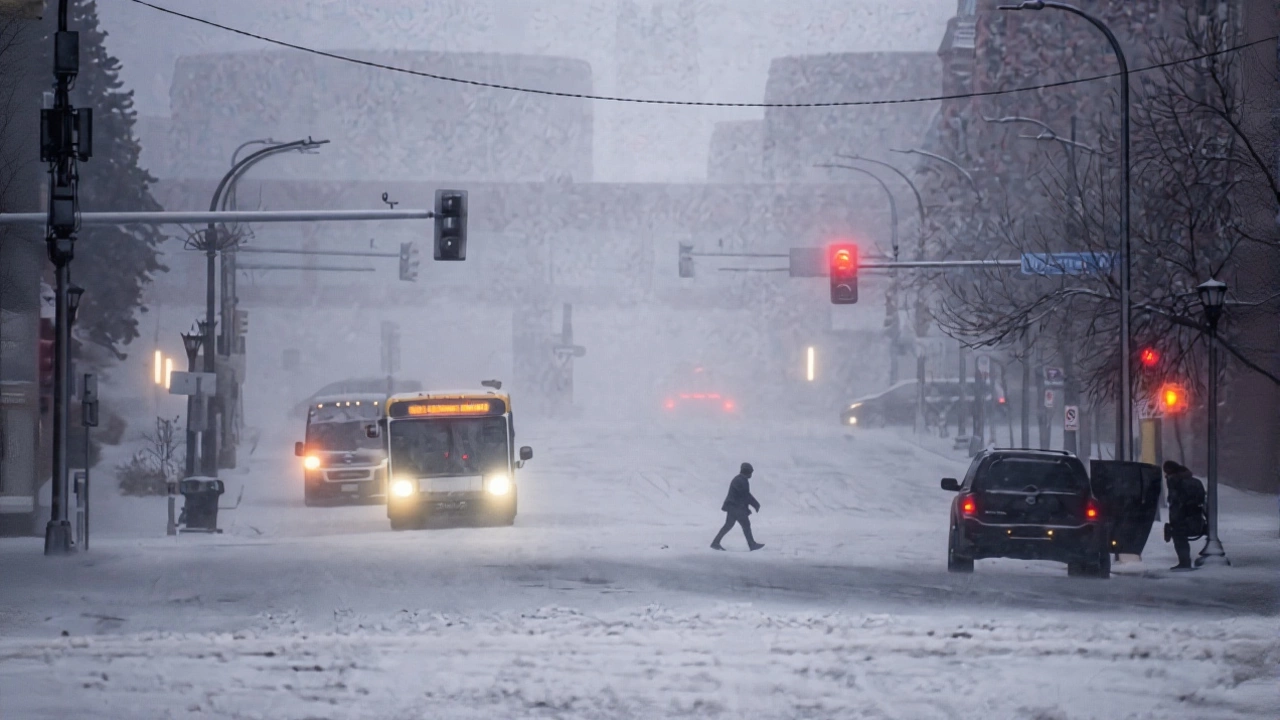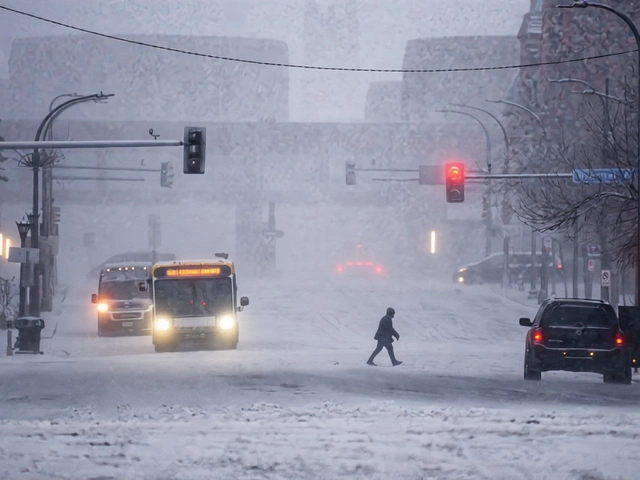A sudden, powerful winter storm slammed into Minnesota on Tuesday night, November 25, 2025, shutting down Interstate 94 for hours and leaving dozens of vehicles stranded as snow piled up to 10.3 inches in Duluth. By 7:30 a.m. Wednesday, November 26, 2025, the National Weather Service had confirmed the state’s first major snowstorm of the 2025-2026 season—with snowfall totals ranging from a light dusting in southern Minnesota to nearly a foot in the north. The storm, which began late Tuesday and continued through the early morning rush hour, triggered multiple crashes, jackknifed semitrucks, and paralyzed travel across the Twin Cities metro and beyond.
Unusually Early, Unforgiving Snowfall
This wasn’t just any November storm. It arrived nearly three weeks ahead of the historical average for Minnesota’s first significant snow event. Meteorologists at FOX 9 called it "a classic early-season bomb"—a fast-moving system that dropped heavy snow on already cold ground, turning roads into ice rinks overnight. The heaviest snow fell between Alexandria and the Brainerd Lakes Area, then stretched northeast through St. Cloud and Pine City, dumping 6 to 8 inches in most of central Minnesota. Moose Lake recorded 8.3 inches; Baxter and Rothsay both hit 7 inches. But nothing compared to Duluth, where snowfall reached 10.3 inches by midmorning.Even the Twin Cities weren’t spared. Minneapolis-Saint Paul International Airport (MSP) logged 3.1 inches—enough to cripple morning commutes. Southern Minnesota, including Winthrop and Monticello, saw just 1.5 to 2 inches. But here’s the twist: the real danger wasn’t just the snow. It was the wind. Gusts hit 35 mph across the region, whipping up blowing snow long after the flakes stopped falling.
Highway Chaos and Emergency Response
By 8 p.m. Tuesday, I-94 was closed from St. Cloud to the Wisconsin border after a chain reaction of crashes—some involving eight or more vehicles. Semi-trucks, caught off guard by the sudden whiteout conditions, jackknifed across lanes, blocking emergency access. The Minnesota Department of Transportation (MnDOT) deployed all available plows and salt trucks, but visibility dropped to near zero in places. One driver told KSTP, "I saw the truck ahead of me spin out, then I hit the brakes—and the next thing I knew, I was sideways, sliding into a ditch. No one was hurt, but I was shaking for an hour."By 5 a.m. Wednesday, MnDOT had cleared two lanes on I-94, but travel remained hazardous. The closure disrupted freight deliveries, school buses, and thousands of commuters. The National Weather Service had issued a winter storm warning until 9 a.m. CST, with winter weather advisories lingering in southeastern Minnesota until mid-afternoon. "This was a textbook example of why early-season storms are so dangerous," said meteorologist Lisa Nguyen of MPR News. "People aren’t thinking winter yet. Tires aren’t changed. Drivers aren’t prepared. One minute it’s drizzle, the next it’s whiteout conditions."
What Happened Next
Snow tapered off by 8 a.m. Wednesday, but the real struggle began after the flakes stopped. Winds kept blowing snow across cleared roads, creating drifts as high as three feet in open fields near Ashby and Chokio. Schools in Rosemount and Shoreview delayed openings. Airlines canceled over 40 flights at MSP. And by noon, MnDOT was already reporting new snow accumulation along I-35, as another cold front moved in."We’ve seen storms like this before—but never this early," said MnDOT spokesperson Tom Reynolds. "Our crews are exhausted. We’re asking people: if you don’t have to be out there, stay home. The roads are still dangerous, even if the snow’s stopped."
Why This Matters
This storm isn’t just a weather event—it’s a warning. Climate data from the University of Minnesota shows that the state’s first measurable snowfall has shifted earlier by nearly 12 days over the past 30 years. November storms like this one are becoming more frequent, more intense, and more disruptive. Insurance claims from the 2024-2025 winter season jumped 27% compared to the previous year, largely due to early-season crashes. And with more people commuting in unprepared vehicles, the risk is only growing.Meanwhile, residents in northern Minnesota are already bracing for what’s next. Forecasts show another storm system moving in by Friday, potentially bringing more snow and subzero temperatures. "We’re not done," said National Weather Service forecaster Daniel Kim. "This was just the appetizer."
What’s Next
MnDOT plans to deploy additional crews and sanding trucks along I-35 and U.S. Highway 10 by Thursday morning. Emergency shelters remain open in Duluth, St. Cloud, and Rochester for stranded travelers. The Minnesota Department of Public Safety is urging drivers to check tire pressure, keep emergency kits in their cars, and avoid nonessential travel until Friday.As for the snow? It’s melting slowly. But the real impact? That’s just beginning.
Frequently Asked Questions
How much snow did Minnesota get during the November 26, 2025 storm?
Snowfall varied widely across the state. Duluth recorded 10.3 inches, the highest total, while Moose Lake and Baxter each received around 8 inches. The Twin Cities metro saw 3.1 inches at MSP, with southern areas like Winthrop and Monticello getting just 1.5 to 2 inches. Preliminary measurements from over 20 locations confirmed the storm’s extreme variability, with central and northern Minnesota bearing the brunt.
Why was I-94 shut down for so long?
Multiple crashes, including several jackknifed semitrucks, blocked all lanes between St. Cloud and the Wisconsin border. Emergency crews couldn’t reach vehicles due to poor visibility and drifting snow. MnDOT had to clear debris, reposition disabled trucks, and treat icy patches before reopening even two lanes—taking nearly 10 hours. The closure disrupted freight and commuter traffic well into Wednesday afternoon.
Was this storm unusual for November in Minnesota?
Yes. Historically, Minnesota’s first major snowstorm arrives in mid-December. This event—marking the state’s first significant snowfall of the season—came nearly three weeks early. Climate data from the University of Minnesota shows such early-season storms are becoming more common, with the average first snowfall date shifting earlier by 12 days since the 1990s.
What made this storm so dangerous?
It wasn’t just the snow—it was the timing and wind. The storm hit during the Tuesday evening commute, catching drivers off guard. Winds gusting up to 35 mph created whiteout conditions even after snow stopped falling. Many vehicles still had summer tires, and drivers weren’t prepared for sudden whiteouts. The combination led to chain-reaction crashes and stranded motorists.
Are more storms coming after this one?
Yes. The National Weather Service has already issued a forecast for another winter system moving into Minnesota by Friday, potentially bringing additional snow and temperatures dipping below zero. MnDOT is preparing for a busy winter season, and residents are being urged to have emergency kits ready, check tire conditions, and avoid unnecessary travel during peak storm windows.
How did this storm affect air travel and public services?
Over 40 flights were canceled at Minneapolis-Saint Paul International Airport on Wednesday morning, with delays stretching into the afternoon. Schools in several metro districts delayed openings or switched to remote learning. Emergency shelters opened in Duluth, St. Cloud, and Rochester for stranded travelers. Public transit systems ran on reduced schedules due to icy roads and visibility issues.





